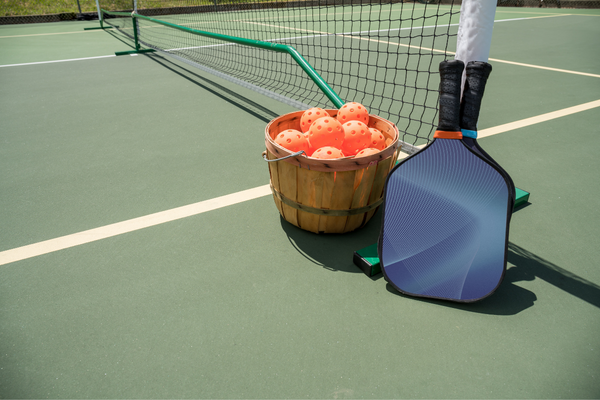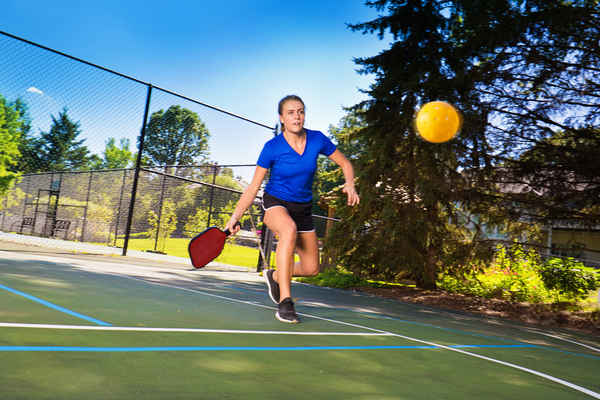Pickleball paddles are highly customizable and can have a profound impact on your playing performance.
When it comes to pickleball paddle materials, graphite vs fiberglass pickleball paddles is a popular comparison. While fiberglass paddles weigh more than graphite paddles, they are fairly sturdy and dynamic too.
In this blog, I’ll explore the pros and cons of each material and help you pick the right paddle for you.
Graphite Pickleball Paddles

Graphite paddles are a popular choice among new players due to the flexibility it offers. Graphite or carbon fiber materials are more lightweight than composite models, but they can be heavy on your pocket!
Graphite materials are not budget-friendly and are thus used mostly by professionals.
Due to their versatility, professional pickleball players prefer the might and feather-light features of graphite surface materials.
Since graphite pickleball paddles give you both control and wrist action, it can be a viable option for even newer players with a history of arm problems.
Pros
The balance and weight of graphite paddles are unmatched as they add power to the paddle while offering great control for its user. Some of the pros of using graphite paddles are:
- It is made from long lasting materials like carbon fiber and titanium
- It adds more control and finesse to the pickleball paddle.
- Extremely durable and strong
- Less stress on elbow and shoulder
- Lightweight
- Provides fantastic ball placement
Due to these reasons, graphite paddles are a better option if you’re looking at playing pickleball professionally or plan to use this particular paddle for a long time. Due to its tactibility and precision, graphite paddles are a popular choice among professional players.
Cons
When it comes to picking pickleball paddles, most players opt for a budget-friendly option. It is imperative to know your price limits while purchasing a pickleball paddle. The amount you splurge on your paddle of choice will largely depend on your wallet. Let’s take a look at some of the cons of graphite paddles.
- Price point. A low-end graphite paddle might cost you about $60 and it can cost up to $145 at the top end of the range.
- Since it is more lightweight, it has reduced power/drive.
- It is generally harder to hit long/hard shots
- Graphite paddles have less texture which inadvertently impacts the spinning capacity.
Overall, graphite paddles are preferably a better option if you are looking to have more control and less wrist action. It is more durable and has better longevity as compared to fiberglass paddles.
Related post: Best Rated Pickleball Paddles
Fiberglass Pickleball Paddles

When it comes to fiberglass vs graphite pickleball paddles, the latter option proves to be more useful for power play.
Although a heavier option, fiberglass or composite paddles offer great range for spins. Due to their textured surface, fiberglass paddles allow you to play with pinpoint accuracy in addition to the immense force of the paddle.
It is quite obvious that heavier paddles offer more power and that is the case with fiberglass pickleball paddles. Let’s look at the pros and cons of a fiberglass or composite pickleball paddles.
Learn the best cleaning tips to maintain your paddle’s performance
Pros
In recent years, fiberglass paddles have gained traction due to their affordability. The manufacturing process of fiberglass paddles involves tiny fibers being pressed together under intense pressure and heat. The fibers are then soaked in resin which hardens the surface material exponentially.
Some of the benefits of using a fiberglass pickleball paddle are listed below.
- Due to its hard exterior, it has more power.
- It typically takes less effort to hit a ball
- Since it has a more textured surface, you have more control over the spin capacity of the ball.
- It is available in more affordable options.
- It offers pinpoint accuracy during a pickleball game
- It tends to concentrate the energy of the ball on the paddle core and thus is more effective in hitting powerful shots
If you want to improve the power of the shots, you should opt for the fiberglass paddles which offer a slightly heavier paddle.
Cons
Fiberglass paddles, also known as composite paddles, focus more on power. While it has its own positive features, there are several downsides of choosing a pickleball fiberglass vs graphite surface material. Keeping that in mind, let’s take a look at some of the cons of fiberglass paddles.
- It offers less control so you will need to exert more force for seamless drop shots and dinks.
- Adds stress on the arm and elbow, making it more prone to injury.
- If played for longer periods of time, it increases fatigue.
- It can be uncomfortable for newer players due to its weight.
- Since it is made with cheaper materials, it is not durable
Fiberglass paddles are a great option if you’re just starting out. If you do not want to invest in a graphite pickleball paddle and are not deterred by these cons, fiberglass paddles is the one for you!
Related post: Illegal pickleball paddles
Fiberglass Vs Graphite Pickleball Paddles

Whether you prefer a lightweight paddle or a budget-friendly alternative, fiberglass vs graphite pickleball paddles are both viable options.
Since both these options are catered towards players, they offer more power and control as compared to other materials like wood.
Let us take a look at some of the main pickleball fiberglass vs graphite key differences.
Weight
Graphite paddles tend to be more lightweight and generally weigh less. You can expect the weight of graphite paddles to be around 7.5 ounces as compared to fiberglass which weighs around 14 ounces.
In hindsight, weight is considered an important factor among pickleball players. The weight determines how well the paddle will respond to the ball and how your body can cope with the added surface material.
If you are on the stronger side, the weight of the paddle shouldn’t make a difference. However, I recommend looking at graphite paddles if you are buying paddles for your children.
Durability
When it comes to the durability of paddles, the cheaper the material the more likely it is to wear out with regular use.
Whether you choose a paddle face made out of graphite or fiberglass, make sure that the surface material includes ultraviolet inhibitors to reduce sun damage and discoloration.
No matter which surface material you choose, make sure that the paddle surface and core have quality constituents.
Learn 7 ways to extend your pickleball paddle’s lifespan.

Cost
One of the most important factors to consider is your budget. There is no point scouring over different paddle materials, if your budget is limited. In fact, it is always better to go for the cheaper option if you are just getting into pickleball.
There is absolutely no need to splurge on an expensive graphite paddle worth $145 if you are using it once in a while. However, if you are a professional or regular player, it makes sense to invest in a more expensive option.
Remember that if it is more expensive doesn’t mean it is a better paddle for you personally. Cheap alternatives like fiberglass paddles are a great choice if you are running on a budget.
Related post: Best cheap pickleball paddles
Spin Precision
When we look at graphite vs fiberglass pickleball paddles comparisons, most players are curious about spin precision. Fiberglass paddles tend to have more texture than graphite paddles and hence, put more spin on the ball.
Control Vs Power
A major pickleball fiberglass vs graphite paddles difference that alters your pickleball experience is the dynamics of control vs power.
If you are someone who likes to control the direction of your ball, then graphite paddles are the best choice for you, especially if you are an experienced tennis player.
On the other hand, fiberglass paddles offer immense power. These paddles are perfect for players who like to add a spin to their shots.
For more details, let’s look at the fiberglass vs graphite pickleball paddles table summary below.
Fiberglass vs Graphite Pickleball Paddle Comparison Table
| Feature | Graphite | Fiberglass |
| Weight | 6 ounces and above | 8-14 ounces |
| Cost | $60-145 | $30-60 |
| Spin Precision | Less spin control | Better spin control |
| Accuracy | Not as accurate as fiberglass paddles | More accurate than other paddles |
| Noise | Generally moderate but it depends upon the core material (a Nomex core is the loudest while polymer core or aluminum core is the quietest | More quiet |
| Convenience | Light paddle and portable | Heavy and might be uncomfortable if played for longer periods of time |
| Risk of Injury | Less risk | Higher risk of injury because its sheer weight |
See the 7 major differences between 13mm vs 16mm pickleball paddles
Which Type Of Pickleball Paddle Is Best For You?

Personal preference always comes into play when you determine the best pickleball paddle for you.
If you are a former tennis player who is transitioning to pickleball, then a heavier paddle would be the best option as your wrist is accustomed to the weight of a tennis racket.
If you prefer light paddles, graphite pickleball paddles are the better option. All materials used in the construction of surface materials come with their own pros and cons. What makes a pickleball paddle best for you is your preference, needs and playing style.
Conclusion
To conclude, graphite and fiberglass paddles are both great options for pickleball players. Depending on your preference and budget, you can easily choose the right one for you.
I hope this pickleball paddle guide helped you make an informed decision in your buying journey. Cheers!
